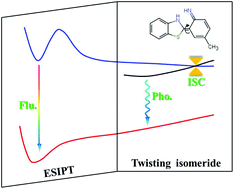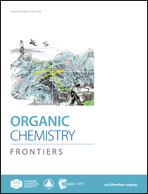Fluorescence deactivation mechanism for a new probe detecting phosgene based on ESIPT and TICT
Abstract
The detection of toxic phosgene is extraordinarily crucial. A fluorescence probe 2-(2-aminophenyl)benzothiazole (abbreviated as probe 1), designed to detect phosgene, had been developed based on an excited state intramolecular proton transfer (ESIPT) process in experiment (L. Y. Chen, D. Wu, J. M. Kim and J. Yoon, Anal. Chem., 2017, 89, 12596–12601). However, the ESIPT mechanism failed to be qualitatively investigated and it is questionable that ESIPT emission of probe 1 was not observed in experiment. In this work, we give in-depth insight into the ESIPT reaction process and non-radiative deactivation mechanism of probe 1 for the first time. Theoretical absorption and fluorescence-emission spectra matched the experimental results. The excited state hydrogen bond strengthening mechanism was verified. The torsional isomer structure of probe 1 was found by building and analyzing the potential energy curves that demonstrate proton transfer just occurs in the excited state. The obtained cross point of the potential energy curves demonstrated that intersystem crossing and phosphorescence are inactivation channels, and the calculated phosphorescence value is 728 nm, which explains the reason behind the unobserved ESIPT-emission spectrum. The frontier molecular orbitals were shown and displayed charge redistribution, which further explains that the quenched fluorescence originates from the twisting intramolecular charge transfer (TICT) character of photoisomerization.

- This article is part of the themed collection: 2019 Organic Chemistry Frontiers HOT articles


 Please wait while we load your content...
Please wait while we load your content...